As scientists so accurately predicted, we are experiencing a historically high amount of coral bleaching this summer/fall in Hawaii. One of the questions that we are frequently asked is, “Is that white coral dead?”
Living corals in their healthiest state are shades of tan, yellow, brown, and green, among other colors. The color they exhibit comes mostly from microscopic single-celled algae called zooxanthellae that live in the coral’s tissue and provide the coral with most of its food.
When the water becomes unusually warm and light intensity increases, the zooxanthellae increase their photosynthesis. As a result the concentration of free radicals, which are a byproduct of this process, exceeds what the coral can deal with, causing membrane damage to the coral. At the same time demand for nutrients by the zooxanthellae increases and exceeds what the coral can provide. Super simplified, it is believed that these two factors together trigger expulsion of the algae by the coral. It is a survival mechanism.
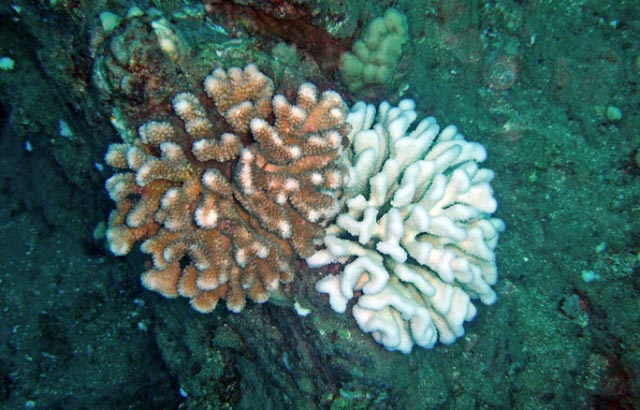
Two cauliflower coral colonies. The one on the left is healthier. The one on the right has expelled its microscopic algae and is referred to as “bleached.” Photo P. Fiene
Once the zooxanthellae are gone – a condition known as “bleaching” – the coral’s white skeleton is clearly visible through the transparent coral tissue and the coral appears dead! (colony on the right in the photo above)
One of the first species to bleach here in Hawaii is cauliflower coral (Pocillopora meandrina). During the third week of September a very high percentage of cauliflower coral colonies at Molokini bleached. Interestingly, the percentage of bleached cauliflower coral is less in water shallower than 30 feet (where presumably the corals or their zooxanthellae are more adapted/acclimatized to high light levels/temperatures and therefore are not experiencing as much “stress”) and deeper than about 90 feet where sunlight is not penetrating to such an extent and temperatures are lower. So at Molokini, the bleaching is greatest between 40-90 feet – the exact depths we are diving.
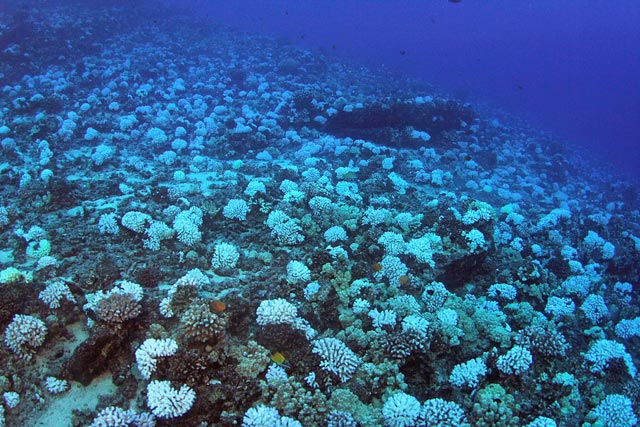
Although these cauliflower coral colonies at Molokini have bleached, they are still alive in this photo from Sept. 23, 2015. Photo: P. Fiene
This leads to some of our divers asking if the bleached cauliflower coral is dead. And the answer is – not so far. Here’s how you can tell.
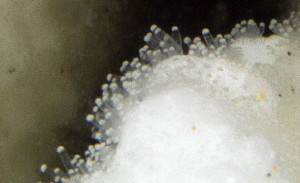
Tentacles of cauliflower coral polyps indicate that the coral is still alive, despite being bleached. Photo P. Fiene
1. Take close-up photos. As a diver, it is not easy to determine if a bleached colony is alive by simply looking at it, but if you take close-up photos you will see the extended tentacles of the polyps. That indicates that the coral is still alive at this time. It does not mean that all is well, however.
Corals derive most (up to 90% in some cases!) of their nutrition from their microscopic algae, so during a bleaching event when the algae are absent, the corals are beginning to starve. They can acquire some energy by capturing food particles with their tentacles, but this is not enough to sustain them long-term. So the ability of bleached corals to survive depends largely on how healthy they were when bleaching occurred, how much lipid (fat) they had stored, how well they can acquire food particles from the water column and how long the temperature remains at a stressful level.
The sooner the corals are able to re-populate their tissue with algae and get back to normal, the better chance they have to survive. But for this to happen the water temperature and sunlight intensity have to drop below a certain threshold – something that is not predicted to occur for at least three more weeks according to this excellent NOAA bleaching forecast.
There may be a positive sign in the close-up photo of the coral’s tentacles above. Cauliflower corals store the lipid (fat) in the tips of the tentacles and perhaps elsewhere in their tissues. In the photo, you can see the opaque white tentacle tips indicating that this coral colony still possesses a store of energy. Will that be enough for this coral colony to survive several more weeks until the water temperature drops below the bleaching threshold?
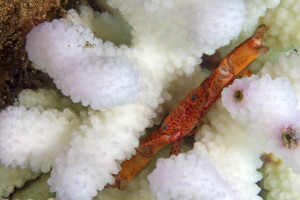
The presence of coral guard crabs (Trapezia spp.) indicates that the coral is probably still alive, despite being bleached. Photo P. Fiene
2. Look for coral guard crabs in branching species.
If they are present, then the coral is probably still alive. This is because the crabs and the coral have a very close relationship. The coral provides the crabs with a home, and with nutrition in the form of mucus. It provides even more food in the form of lipid stored in the tips of the tentacles. The crabs in turn provide protection against predators such as the crown-of-thorns sea star. They also increase water circulation among the coral’s branches, among other benefits.
These crabs are not easy to see however. At night they are actively moving about the colony. But during the day they are deep within the branches. Very close observation and a light are necessary.
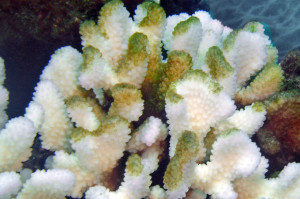
Part of this cauliflower coral colony has died and tan turf algae has colonized the dead branch tips. Photo P. Fiene.
3. Look for evidence of turf algae beginning to grow on the coral skeleton.
When the coral is alive the coral’s tissue produces mucus which prevents turf algae (tiny seaweed) from finding a place to grow on it. If a colony or part of a colony has died there is no longer tissue to prevent turf algae from colonizing the surface and beginning to grow. If you see a brownish or greenish coating on the white skeleton, then at least that part of the coral colony is no longer alive.
Right now we will have to wait and see what percentage of corals in Hawaii will be resistant to bleaching or will “survive” the bleached state by re-populating their tissue with microscopic algae. Molokini’s reefs are faring better so far compared to the high mortality in some places around Maui. However, even if most of the corals at Molokini survive this year’s bleaching, they may experience reduced reproductive ability, reduced growth or reduced immunity. For now, at the beginning of October, we are hoping the outcome will be one of survival rather than one of recovery from a severe die-off.
An excellent source to learn more than you ever wanted to know about coral bleaching can be found here: http://www.coris.noaa.gov/activities/reef_managers_guide/reef_managers_guide_ch4.pdf
by Pauline Fiene. Photos as credited.

Comments 6
Great info as always. Let’s hope for the best. Thanks Pauline.
Great blog, Pauline!
Nice article, thanks for sharing!
I report that about 95% of cauliflower corals are bleached down to about 80 feet in Kailua Kona. I’ve never seen anything like this here in Hawaii since I moved here in 1996.
Author
Zoltan, yes, it is a historically high amount of bleaching. Have you heard about the statewide event this Saturday Oct. 3 to report coral bleaching? You can read about it here: http://eorhawaii.org/
Thank you Pauline! What a great summary/review of what we are seeing and what is happening out there. My first response was that the situation was grim. But lets hope that the coral can hang in there and return to full life as we know it.